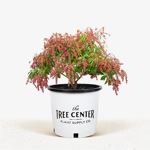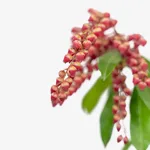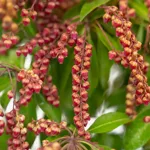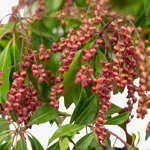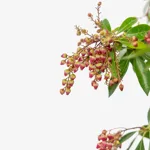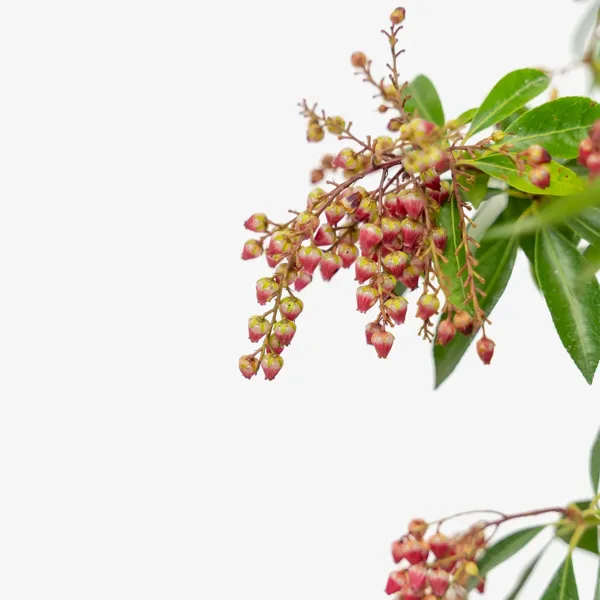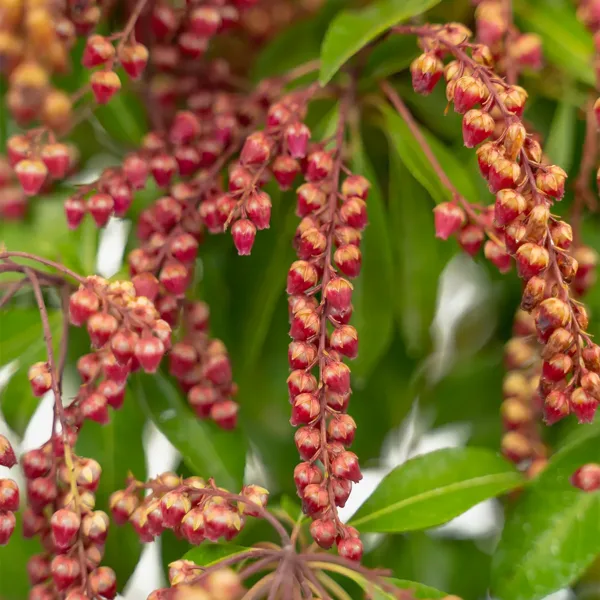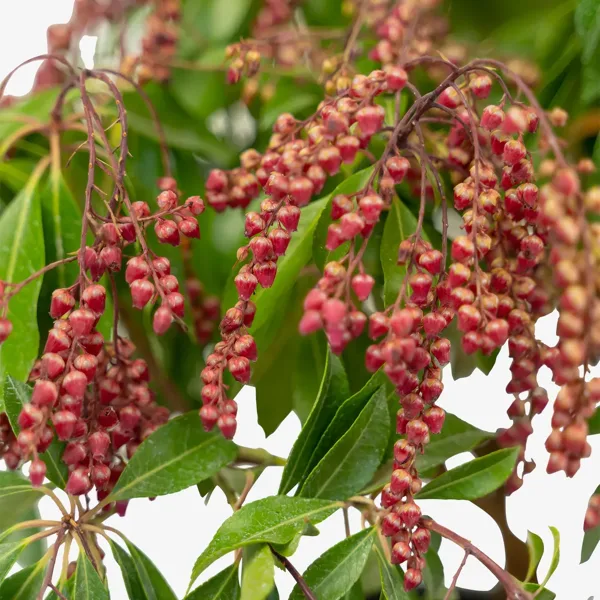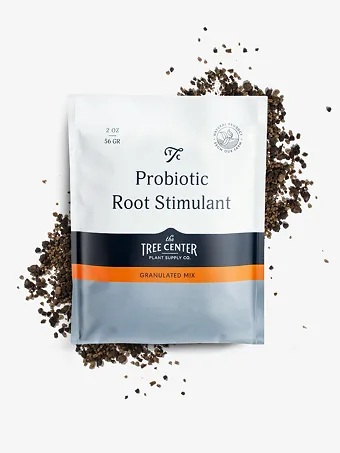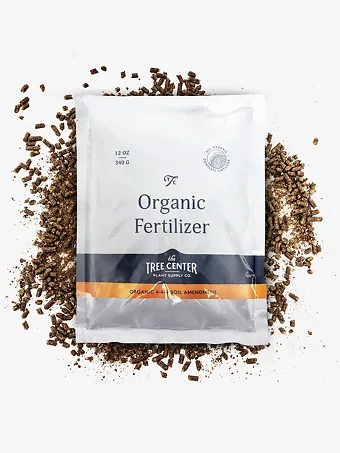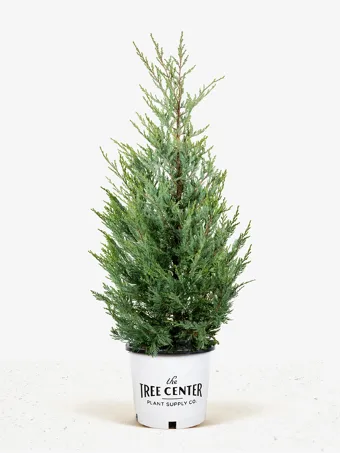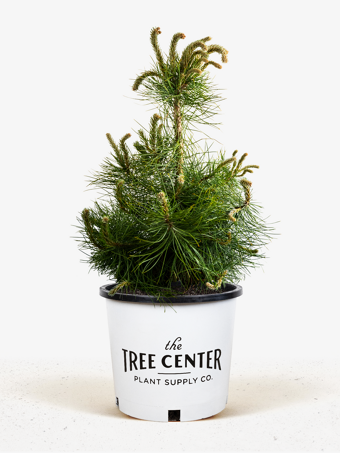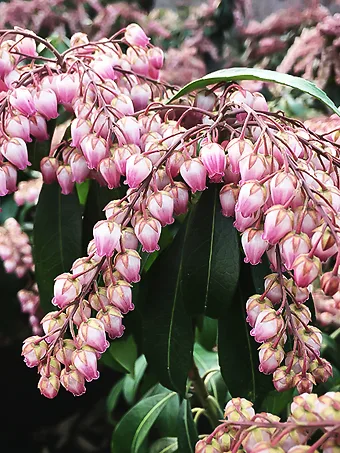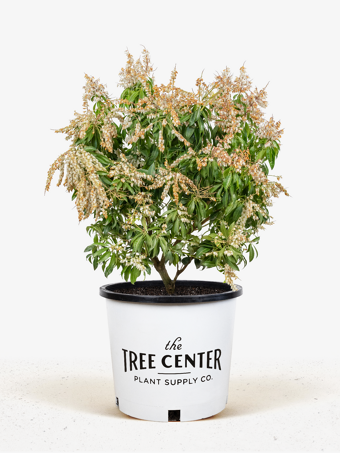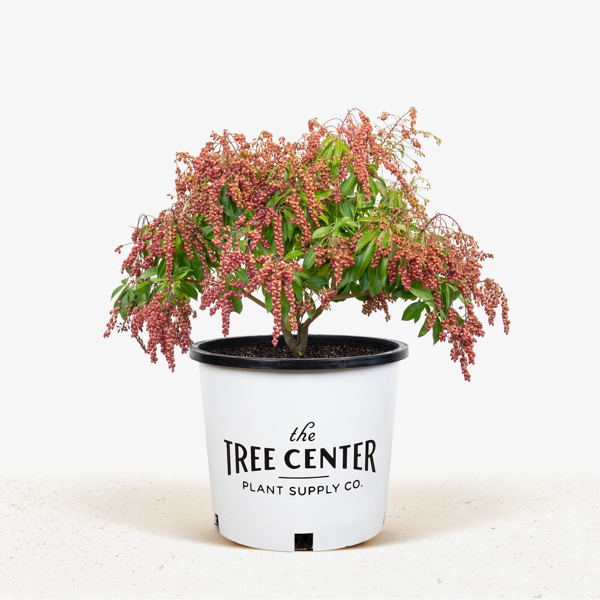
Valley Valentine Pieris
Pieris japonica 'Valley Valentine'View more from Pieris
Valley Valentine Pieris
Pieris japonica 'Valley Valentine'
Select Size
30 day - ARRIVE AND THRIVE™ guaranteeLearn more


Special Features

Botanical Name
Pieris japonica 'Valley Valentine'
Outdoor Growing zone
6-8
Mature Height
4-7
Mature Width
4-6
Sun needs
Partial Sun, Shade
The Valley Valentine Pieris is a sturdy and reliable evergreen shrub growing 4 feet tall and wide, and ultimately passing 6 feet. It has leathery, dark-green leaves, which are orange-bronze when newly emerging in spring. The flowers are carried in profuse heavy clusters of hanging bunches, and they are a deep, rich reddish-pink color – one of the darkest and richest color of all Pieris, which are normally white. The flowers develop slowly over winter, and they are attractive even before opening in early spring. Grow this plant in shady parts of your garden, around your home or beneath trees.
- The darkest pink blossoms of any Pieris
- Vigorous and reliable evergreen bush
- Massive flower display of hanging blossoms
- Attractive orange-bronze new leaves
- Perfect for shady parts of your garden
The Valley Valentine Pieris grows best in partial shade, with morning sun and shade from noon. It also grows well in dappled shade beneath evergreen trees. The soil should be moist, well-drained, rich, and acidic, although Pieris are less demanding for this than rhododendrons are. Pests, diseases and deer usually leave this plant alone, and it needs no pruning or trimming – just remove the dead flower heads.
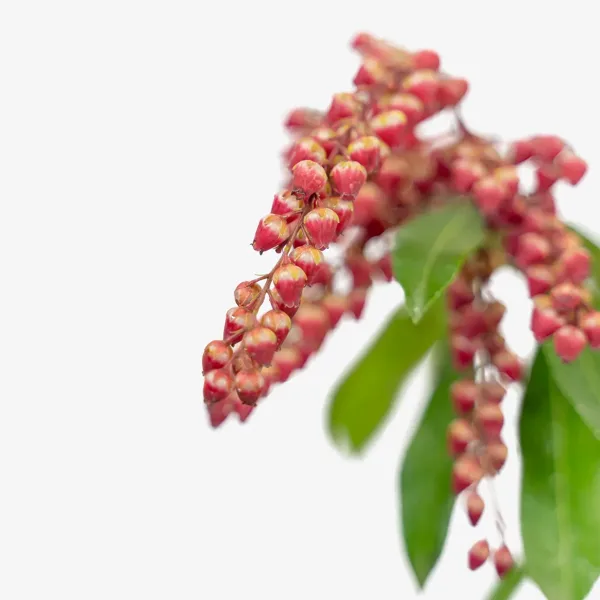
Pieris, Andromeda, Lily-of-the-valley bush – whatever you call them there is no doubt that they are among the most outstanding of all the spring flowering evergreen shrubs, and one in bloom is a glory to behold. Almost all of them have white blooms, but in 1953 a variety called ‘Flamingo’ was discovered in the USA. That early form has been improved on, and for blossom size and color, the very best pink available is today the Valley Valentine Pieris. An outstanding plant, it is more vigorous and faster-growing than many others in any color, and it has been extensively tested and trialed to prove it. Smothered in huge pendulous sprays of deep reddish-pink blooms, set off against the rich green leaves, it truly is a wonderful addition to your garden.
Growing the Valley Valentine Pieris
Size and Appearance
The Valley Valentine Pieris is a medium-sized evergreen shrub, forming a broad mound of branches, which will grow to 4 feet tall within 10 years. Ultimately it will grow over 6 feet tall and wide, so remember to plan enough room for its final size when planting it. It has many branches rising from the base, keeping foliage close to the ground for many, many years. The leaves are about 2 inches long and almost an inch wide. They are leathery, glossy, smooth and dark green, with fine serrations along the edges. In late spring new leafy shoots sprout out as the flowering is coming to an end. These are orange-bronze, adding a new touch of beauty and extending the spring interest for this plant. The leaves stay green and healthy all through the winter months.
In fall you will see tiny, claw-like shoots forming at the ends of the stems. These are the flowers for the next spring, and they develop slowly through winter, speeding up as spring approaches, and elongating into pink hanging stems at least 6 inches long. These open into hanging bells of a rich deep pink, with just a touch of white at the bottom as they mature. This is perhaps the darkest pink of all Pieris, and it flowers profusely, with many flower clusters topping each stem, making a rich and powerful display. If you have grown Pieris that didn’t flower well, try this one – it’s a winner.
Using the Valley Valentine Pieris in Your Garden
Wherever you have partial shade, such as on the east-facing side of your home, or where you have open, scattered shade beneath deciduous trees, those are ideal places for the Valley Valentine Pieris. Grow it among other evergreens around your home or out in garden beds, perhaps with rhododendrons, azaleas and camellias. Grow it in open wooded places, along paths or in clearings, where it will be a joy to visit each spring. If you don’t have suitable soil, grow it in a large planter or tub, using potting soil for acid-loving plants.
Hardiness
This plant grows from zone 5 to 8, doing especially well in areas with cooler, moist summers and mild winters. In zone 5 choose a warm, sheltered spot with a good amount of sunlight.
Sun Exposure and Soil Conditions
Morning sun and afternoon shade are ideal for the Valley Valentine Pieris, but it will also grow well in open shade. Grow it in moist, well-drained, rich soil, that is acidic, with a pH of less than 6.5. Pieris are able to tolerate neutral soils too (pH up to 7.0), especially if it is enriched with lime-free compost, peat moss or rotted leaves and pine needles. Use chelated iron in spring and fall if the new leaves develop yellow or pale green coloring. If you have alkaline soil, in zones 7 and 8, you can grow this plant successfully in containers, using lime-free potting soil and feeding regularly with azalea food.
Maintenance and Pruning
No pruning is needed for the Valley Valentine Pieris – it is naturally compact and neat. Remove the dead flower heads once blooming is over, to prevent seeding and divert the plant’s energy into flower buds for the next year. Pests and diseases are normally not problems, and deer usually leave this bush alone.
History and Origin of the Valley Valentine Pieris
The Japanese andromeda, Pieris japonica, is native to the islands of Japan and Taiwan. It also grows in parts of China. A range of varieties are available, but almost all of them have white flowers. Dr. Robert Ticknor was a horticulturist and plant breeder at Oregon State University’s North Willamette Research and Extension Center, near Aurora. He creates new varieties of plants to help the large local nursery industry. In the 1960s he worked on Pieris, developing new, improved methods for breeding them and becoming an expert. He created three valuable new varieties – ‘Valley Fire’, with white flowers, and ‘Valley Rose’ and ‘Valley Valentine’, both with pink flowers. ‘Valley Valentine’ was developed from seedlings grown from a cross between ‘Valley Rose’ and an older plant called ‘Flamingo’, an early pink variety named by Dr. Ticknor in 1953 but developed by Lambert Gardens, an Oregon nursery. These plants were all only released after extensive trials to establish their worth and reliability. Dr. Ticknor loved his Pieris so much that he had his ashes scattered under bushes of them growing in his home garden.
Buying the Valley Valentine Pieris at The Tree Center
Dr. Ticknor trialed and tested his plants extensively before releasing them, so you can be sure this plant is reliable and top quality. It was given the Award of Garden Merit in 1993 by Britain’s Royal Horticultural Society, another badge of quality. We know you will love this bush in your garden, but order right away, because our stock is very limited, and we know that the last plant will be leaving our farm very soon.
